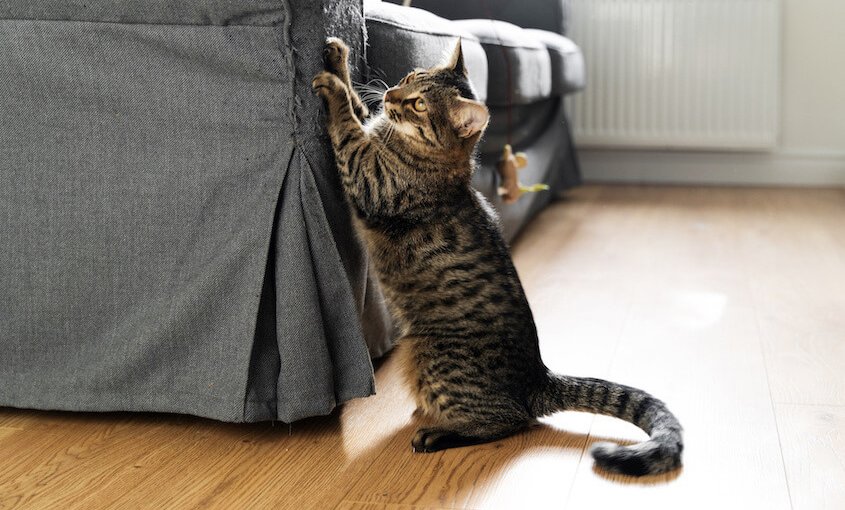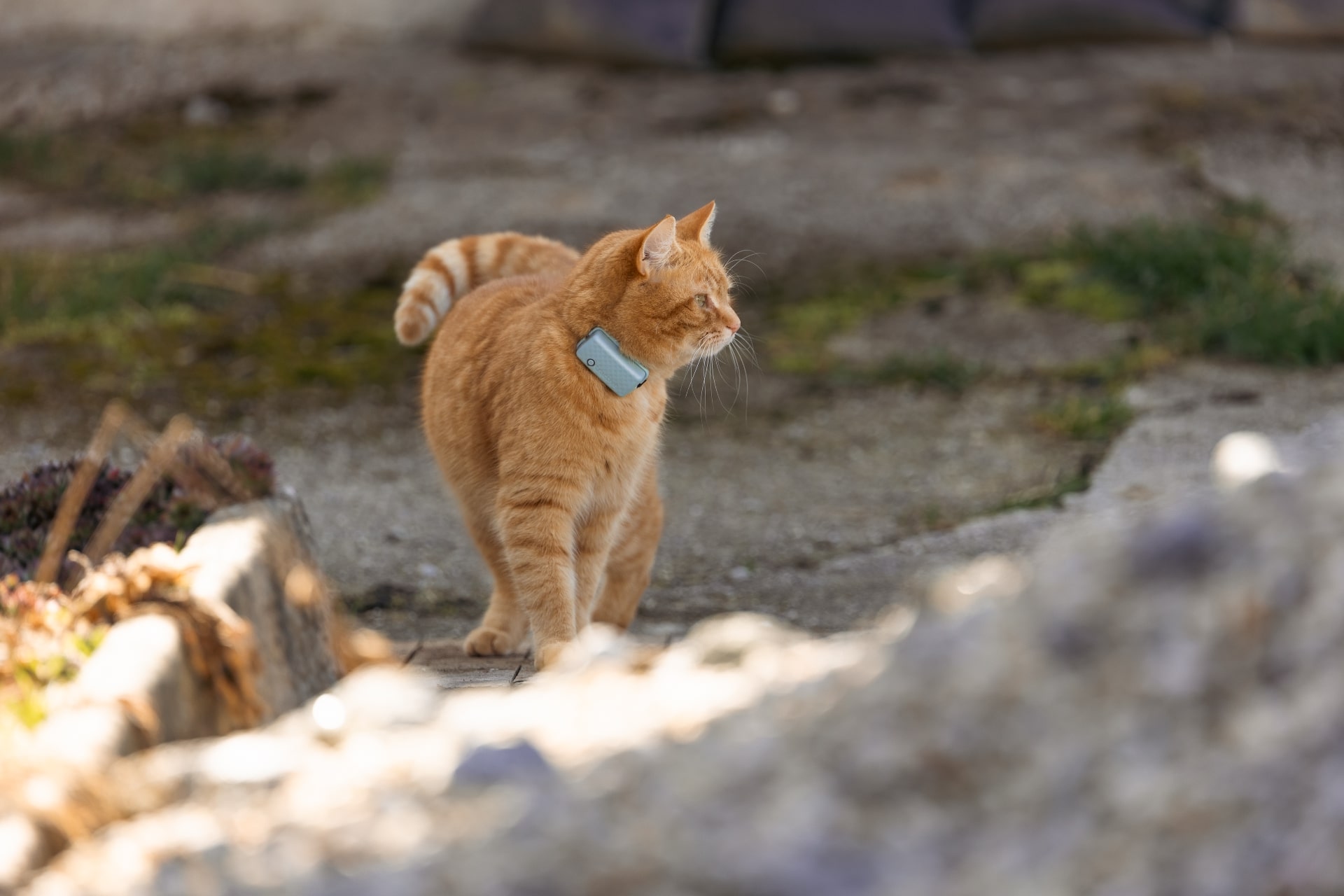How To Stop A Cat From Scratching Furniture
Furniture and cats aren't always the best mix. But have you ever wondered why they do it in the first place? And how to get them to stop?

Even the most docile cats have natural instincts that surface in some interesting ways. Case in point: scratching the living daylights out of your couch, door, or carpets. Here’s why they do it, how to stop a cat from scratching your furniture, and how keeping them active and letting them outdoors safely can help redirect their energy.
Key Takeaways
Common causes of why cats scratch include to mark territory, keep their claws healthy, stretch their muscles, and relieve stress.
You can keep your furniture scratch-free by introducing scratching posts, pads, or cat trees made from materials like cardboard or wood. Place them near areas your cat frequently scratches and reward them plenty when they do use them.
Some cat-friendly deterrents include double-sided tape or aluminum foil to furniture. Keep your cat’s claws trimmed and consider using furniture covers to minimize damage.
If you redirect your cat’s scratching outdoors, a smart cat collar with GPS tracking (like Tractive) can help keep them safe at every step with real-time tracking.

Find out where your cat spends their time.
Read moreWhy do cats tend to scratch things in the first place?
Cats scratch things as a result of their natural instincts.1 Like, for example:
- Marking territory
Cats have scent glands on their paws – so leaving scratches is how they indicate their presence and territory to other cats. - Keeping their claws sharp
Scratching helps cats shed the outer layers of their nails, which help keep them healthy and sharp. Wild cats (including big cats) also tend to scratch trees for the same reason. - Stretching
Cats stretch way out and flex their bodies while scratching – which can be a form of exercise in itself. - Stress
Which might result in excessive scratching due to any pent-up energy. Like from being cooped up indoors for too long or if they’re experiencing a massive change in routine.
How to stop a cat scratching furniture in its tracks
Provide your cat a scratch-friendly alternative
When you offer your cat a designated “scratching” item, you signal to them that you’re not punishing them. For example, you could provide them scratch posts, pads, or a full cat tree made from materials similar to the texture of your furniture – like cardboard or wood. Initially, we’d recommend you place these close to where your cat tends to scratch the most. (Like your couch or bed). With time, shift them further away. Your cat will gradually learn the difference and head to the “correct” scratching area.
Reward your cat when they scratch the “right” spots
Once you’ve set up a scratching post or board and you see them using it, reinforce this behavior. Offer your cat a ton of treats, praise, and plenty of cuddles. Cats respond well to positive reinforcement – so they’ll begin to associate using the scratching post with a positive experience. (I.e. getting affection and attention from you.) So if you consistently praise or cuddle your cat when they use the scratching post, it’ll encourage them to use it instead of your furniture in the future.
Keep your cat’s claws trimmed
Shorter feline nails are less likely to cause significant damage to your sofa, curtains, or carpets. We’d recommend you trim your cat’s nails every 2-3 weeks with a vet-approved nail clipper. Take care not to cut too close to the quick. These areas contain blood flow – which might cause your cat pain. Finally, use a “guillotine”-style blade to make a quick, clean cut.
Not sure how to get started? Here’s a 5-step guide on how to trim your cat’s nails safely by yourself at home. Just keep in mind that trimming your cat’s nails might not be necessary if they’re an outdoor cat. They likely have enough natural scratching surfaces to keep them sharp. In case you’re not sure how to get started with trimming your cat’s nails, make sure to get in touch with your local vet or a professional pet grooming service.
Use furniture covers or slipcovers
A furniture cover or slipcover can help protect the surface of your couches or chairs. They help provide a physical barrier between your cat’s claws and furniture and minimize any damage they might cause. We’d recommend going for slipcovers you can easily put on and off and can wash easily. Another cover we recommend are blankets. Cats love the soft texture of blankets and tend not to scratch them.
💡 Place double-sided tape, aluminum foil, and sticky mats near or on your furniture. Cats generally dislike these textures and it’ll discourage them from venturing close to them.
Use a scent repellent on your furniture
Cats hate certain smells, including citronella, citrus, and rosemary. You can create a homemade spray by mixing a few drops of essential oil with water and spraying your furniture.
We’d only recommend going for this option if none of the other tips work. Cats are sensitive to smells and it’s always better to ensure they’re comfortable. So if you live in a smaller flat, it’s likely your homemade spray might spread around your entire house. And if your cat disapproves of the smell, you might find them getting even more agitated and unruly as a result.
Help your cat reduce their stress
Cats tend to be creatures of routine and habit – and change can be stressful. So if you’re observing your cat scratching, crying, or meowing excessively, it might be a sign they’re experiencing stress. So take some time to observe what might be causing it. (Like if you’ve just moved houses or introduced them to a new pet.) Give your cat time to adapt – and make sure to provide them a safe, secure environment full of toys, treats, and your presence.
Redirect your cat’s scratching outdoors
Letting your cat outdoors helps redirect your cat’s scratching behavior to outdoor objects instead. Even your indoor cat can “extend” their territory from your sofa to the backyard – and can scratch an outdoor tree instead of your table legs.
Though if you’re afraid of the dangers your cat might run into outdoors, we do get it. (Especially if your indoor cat hasn’t had much experience.) There’s no end to the passing cars, dangerous wildlife, poisonous plants, or even pet thieves your cat might run into. Make sure your cat is at least wearing a collar with an ID tag with your contact details. Ideally, they’re also microchipped to prove you’re their rightful owner.
💡A cat GPS tracker can also help you keep tabs on your cat’s real-time location every few seconds – with just a glance at your phone. So you’ll never need to worry about losing them ever again.

Track your cat wherever they go
Get real-time location information, wherever they go. Find out when they go somewhere they shouldn’t, with Virtual Fences. And discover their favorite spots with Territory.
What to do if your cat refuses to use a scratching post
Familiarize your cat with their “new” scratch area
Your cat might be reluctant to try your new scratching post because it might seem unfamiliar or strange. So start slow. Introduce your cat gradually to it to help them familiarize themselves better. Play or spend some cuddling time with them near your new scratching item. Keep their favorite toys around and gradually build up their familiarity with their new scratching item.
You could also place your new scratching post near your cat’s favorite parts of your house – so you can safely and easily “distract” them away from your furniture. For example, you could place it right next to where they sleep, so they can get their daily scratching time first thing in the morning.
Experiment with different shapes, sizes & materials
- Shapes
Your cat might ignore a horizontal scratching post – but jump right at a vertical cat tree. In general, cats enjoy vantage points where they can survey their surroundings. So play around with some different shapes to get a feel of which one your cat responds best to. - Sizes
If your cat is on the larger side, they might enjoy a larger, sturdier scratching post more. (Since they tend to rub their entire bodies against them.) - Materials
Try different materials (like carpet, wood, or even rope) for one that’s just right for your cat.
💡Try multiple scratching items, like scratching tape, posts, and floor scratchers. Rotate these periodically to keep your cat distracted from the rest of your furniture.
Rub a treat near the scratch post
Your cat might be more likely to approach a scratching post or tree if it smells familiar. You could try rubbing a bit of their regular food on the scratching item to encourage them to approach and interact with it. If you’re a fan of houseplants, catnip is a great option – both for creating a gorgeous green indoor space and keeping your cat happy. Catnip is perfectly safe for cats to sniff, consume, and grow around the house.
Let your cat outdoors – safely
If a nearby tree is the only option and your cat is itching to explore the wild outdoors, make sure they’re easily identifiable with a collar and ID tag. You’re best off letting your neighbors know as well, so they know to expect your furry buddy prowling around their backyards. Better yet, a cat microchip works like a permanent ID tag for your cat and can help avoid them getting mistaken for a stray and “adopted” out of nowhere.
💡And if you’re worried your cat might wander off a bit too far or get lost, consider strapping a GPS tracker to their collar.

Which can help you:
- Track your cat’s location in real-time – no matter how far they roam
Just switch on LIVE mode via your Tractive mobile app – and follow their every step, as they make their every step. Better yet, unlike an AirTag, Tractive GPS trackers aren’t limited to a network of compatible devices to work. Nor limited to any range. - Figure out where your cat spends most of their time
From your cat’s Location History, so you can understand your cat’s favorite hunting, hiding, or hangout spots. Now in an emergency, like if they get lost, you’ll know where to look first. - Get alerted if your cat escapes
Set up a “safe zone” around your home or backyard from your Tractive mobile app – and get an escape alert if your cat leaves it.
All this and more – all in one device, built with love for cats and for your peace of mind as a cat parent.



